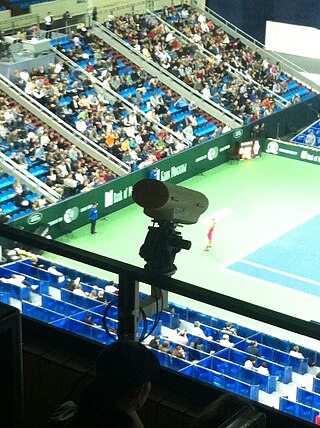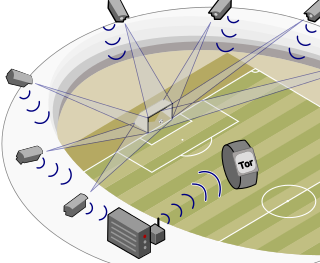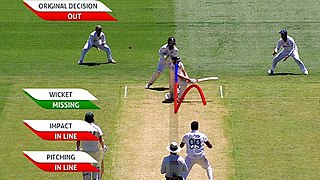The Fraunhofer Society is a German publicly-owned research organization with 76 institutes spread throughout Germany, each focusing on different fields of applied science. With some 30,800 employees, mainly scientists and engineers, and with an annual research budget of about €3.0 billion, it is the biggest organization for applied research and development services in Europe. It is named after Joseph von Fraunhofer who, as a scientist, an engineer, and an entrepreneur, is said to have superbly exemplified the goals of the society.

In association football, the referee is the person responsible for interpreting and enforcing the Laws of the Game during a match. The referee is the final decision-making authority on all facts connected with play, and is the match official with the authority to start and stop play and impose disciplinary action against players and coaches during a match.

Hawk-Eye is a computer vision system used to visually track the trajectory of a ball and display a profile of its statistically most likely path as a moving image. It is used in more than 20 major sports, including cricket, tennis, Gaelic football, badminton, hurling, rugby union, association football and volleyball,
The Laws of the Game are the codified rules of association football. The laws mention the number of players a team should have, the game length, the size of the field and ball, the type and nature of fouls that referees may penalise, the offside law, and many other laws that define the sport. During a match, it is the task of the referee to interpret and enforce the Laws of the Game.

A corner kick, commonly known as a corner, is the method of restarting play in a game of association football when the ball goes out of play over the goal line, without a goal being scored and having last been touched by a member of the defending team. The kick is taken from the corner of the field of play nearest to the place where the ball crossed the goal line.
Instant replay or action replay is a video reproduction of something that recently occurred, both shot and broadcast live.

The SCMaglev is a magnetic levitation (maglev) railway system developed by Central Japan Railway Company and the Railway Technical Research Institute.

The 2013 FIFA Confederations Cup was the ninth FIFA Confederations Cup, which was held in Brazil from 15 to 30 June 2013 as a prelude to the 2014 FIFA World Cup. The most recent winners of the six continental championships appeared in the tournament, along with hosts Brazil and UEFA Euro 2012 runners-up Italy, who qualified because the Euro 2012 winners, Spain, had also won the most recent FIFA World Cup in 2010 thus securing a spot in the tournament.
Bernhard Grill is one of the developers of the MP3 technology.

An electronic line judge is a device used in tennis to automatically detect where a ball has landed on the court. Attempts to revolutionize tennis officiating and the judging of calls in the sport began in the early 1970s and has resulted in the design, development and prototyping of several computerized, electronic line-judge devices. The methods have been based upon the use of pressure sensors, sensors to detect magnetized or electrically conductive tennis balls, infrared laser beams, and most recently video cameras.

In association football, goal-line technology is the use of electronic aid to determine if a goal has been scored or not. In detail, it is a method used to determine when the ball has completely crossed the goal line in between the goal-posts and underneath the crossbar with the assistance of electronic devices and at the same time assisting the referee in awarding a goal or not. The objective of goal-line technology (GLT) is not to replace the role of the officials, but rather to support them in their decision-making. The GLT must provide a clear indication as to whether the ball has fully crossed the line, and this information will serve to assist the referee in making their final decision.

The 2012 FIFA Club World Cup was a football tournament that was played from 6 to 16 December 2012. It was the ninth edition of the FIFA Club World Cup, a FIFA-organised tournament between the winners of the six continental confederations as well as the host nation's league champions. The tournament was hosted by Japan.
The Swiss Federal Laboratories for Materials Science and Technology is a Swiss research institution for application-oriented materials science and technology. It has three locations – Dübendorf, St. Gallen and Thun. As part of the ETH Domain, it is assigned to the Federal Department of Economic Affairs, Education and Research (EAER). For more than 100 years since its foundation in 1880, Empa has been a material testing institute. Since the late 1980s, it has increasingly transformed into an interdisciplinary research institute for materials and technologies.

The Decision Review System (DRS), formerly known as the Umpire Decision Review System (UDRS), is a technology-based system used in cricket to assist the match officials in their decision-making. On-field umpires may choose to consult with the third umpire, and players may request that the third umpire consider a decision of the on-field umpires.
Unified Speech and Audio Coding (USAC) is an audio compression format and codec for both music and speech or any mix of speech and audio using very low bit rates between 12 and 64 kbit/s. It was developed by Moving Picture Experts Group (MPEG) and was published as an international standard ISO/IEC 23003-3 and also as an MPEG-4 Audio Object Type in ISO/IEC 14496-3:2009/Amd 3 in 2012.

Vieww, previously known as GoalControl, is a German company based in Aachen, which provides technologies for use in sports.
Fraunhofer FDK AAC is an open-source library for encoding and decoding digital audio in the Advanced Audio Coding (AAC) format. Fraunhofer IIS developed this library for Android 4.1. It supports several Audio Object Types including MPEG-2 and MPEG-4 AAC LC, HE-AAC, HE-AACv2 as well AAC-LD and AAC-ELD for real-time communication. The encoding library supports sample rates up to 96 kHz and up to eight channels.

The video assistant referee (VAR) is a match official in association football who assists the referee by reviewing decisions using video footage and providing advice to the referee based on those reviews.

Futsal began in the 1930s in South America as a version of association football, taking elements of its parent game into an indoor format so players could still play during inclement weather. Over the years, both sports have developed, creating a situation where the two sports share common traits while also hosting various differences.
LC3 is an audio codec specified by the Bluetooth Special Interest Group (SIG) for the LE Audio audio protocol introduced in Bluetooth 5.2. It's developed by Fraunhofer IIS and Ericsson as the successor of the SBC codec.










